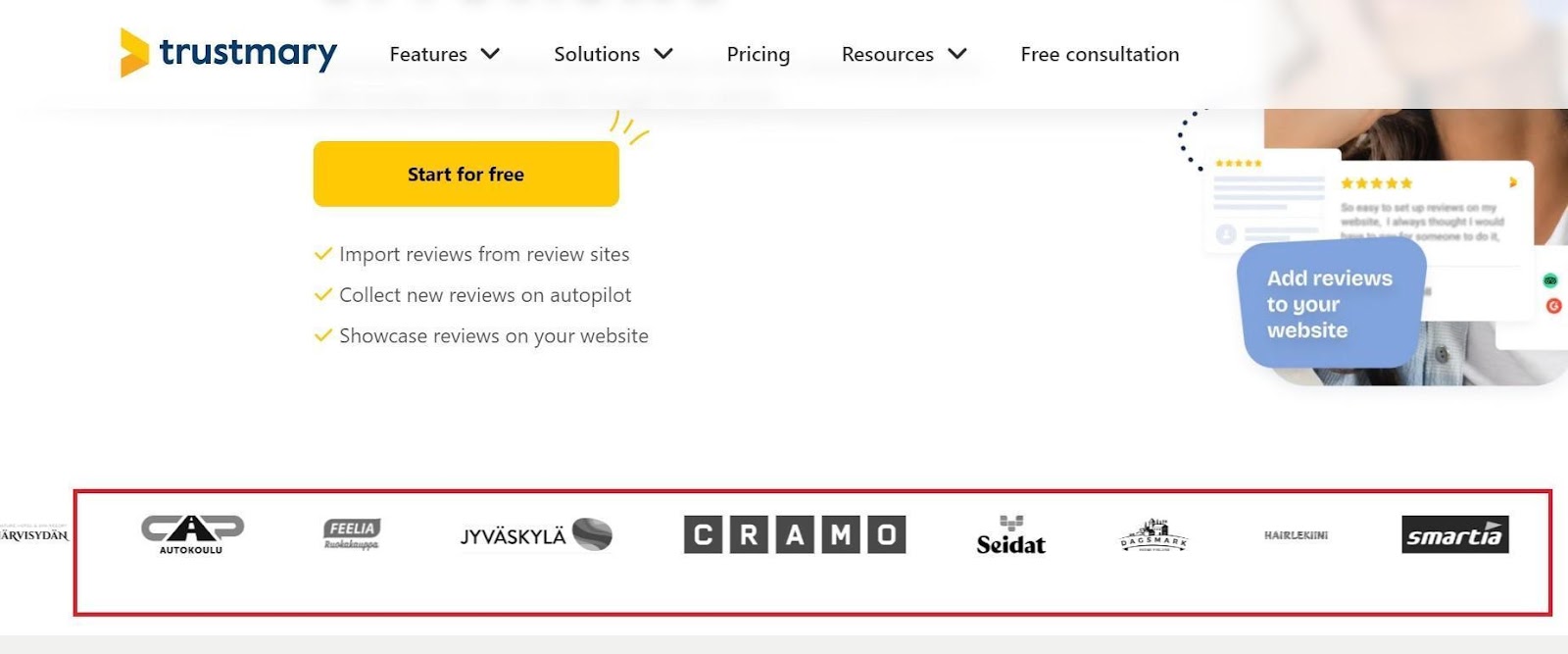Reputation Marketing: Definition, Benefits, Best Practices


What do you get when you merge brand marketing with reputation management?
Two words: reputation marketing.
Right now, reputation marketing is to your company what branding is to your product. Granted, it's still an emerging advertising form, yet that doesn't diminish its effectiveness.
The best part? Reputation marketing actively focuses on leveraging positive customer reviews and testimonials. You know, the ones that you spend hours laboring over? Yes, those.
In this article, we'll explore what the concept means and the content types it prioritizes. Then, we'll discuss what it can offer and a few best practices to be mindful of.
Let’s get down to it.
What exactly is reputation marketing?
Today, everything about your brand and product is easily accessible online.
Customer reviews, social media mentions, press releases—your buyers can skim through it all and form distinct opinions about your business.
Reputation marketing, then, involves strategically shaping that material to curate a favorable online presence. Unlike traditional advertising, it focuses on what customers have to say.
That said, don't mistake reputation marketing for reputation management.
Reputation management is a 'blanket' strategy that directs or controls the narrative around a brand, especially in crises. Take Lyft as an example.
In 2023, a Lyft driver took off with a passenger’s pet cat still in the car. The customer then took to social media to talk about the incident. The post garnered significant engagement, with thousands of users demanding Lyft to get involved in the matter.
Eventually, the company hired investigators and found the cat. Put simply, Lyft identified a potential PR fiasco and promptly addressed it.

(Source)
Meanwhile, reputation marketing proactively creates or amplifies positive branded and user-generated content to aid broader promotional efforts. In some cases, this could mean leveraging social listening to boost brand image and perception.
One such example comes from Stanley, a company specializing in thermal mugs and bottles.
In 2023, a TikTok user posted about how their Stanley bottle survived a car fire. Incidentally, this only highlighted the product's 'built for life' message.
Soon enough, the reel had over 95 million views. Stanley's CEO, Terence Reilly, soon responded to the post and offered to replace the car. His reply quickly gained traction and earned the brand over 21,000 mentions on the site.

(Source)
In most cases, reputation marketing and reputation management work in tandem. Both aim to cultivate a favorable brand perception. The difference lies in their approach and application.
What kind of content does reputation marketing prioritize?
By its very nature, reputation marketing involves using branded and user-generated assets as promotional material.
Naturally, this strategy favors a few specific content formats over others. Some of these include but are not limited to:
- Online customer reviews: From specialized sites to Google reviews, this is perhaps the most critical content type that falls under the purview of this marketing approach. In fact, studies show that over 90% of buyers read online reviews before shopping.
- Social media content: User comments or brand mentions on sites like Facebook, Instagram, and X can significantly impact customer perception. Suffice it to say, a well-conceptualized reputation marketing strategy takes such material into account.
- Press releases: Company communications, brand announcements, and news have a considerable effect on how consumers view your organization. This extends to not just the content itself but also how it's framed when presented to consumers.
- User-generated material: Customer testimonials, online recommendations, and shared experiences influence public opinion of your brand and product. One report suggests that 88% of purchasing decisions are influenced by such content.
In addition to that, broader digital marketing material also plays a role here. This includes your website content (accolades, badges), Google ads, and social media content. Generally, you want your strategy to cover everything that customers interact with.
Should brands create a reputation marketing strategy?
When implemented correctly, reputation marketing can seamlessly enhance your market image and position. Better yet, it’ll result in customers forming a deeper connection with your brand/product.
Here’s how some of this plays out:
1. Better brand equity
Brands with a positive online reputation practically promote themselves. More importantly, consumers perceive such companies (and their products) to have more ‘social value’ than market alternatives.
Case in point, reports indicate that 35% of buyers are willing to pay a premium for a product/brand that they trust. That’s not all. Better brand equity directly translates to improved customer loyalty, which, in turn, stabilizes cash flow.
2. Increased customer trust
A considerable number of shoppers trust online reviews from a brand's existing customers.
These prospects give such testimonials and reviews the same importance as recommendations from friends and family. Recent data puts this portion of buyers at roughly 49%.
So, what does this all mean?
Essentially, when you foster positive reviews through reputation marketing, you build trust with future customers. And the more effort you put into generating user reviews, the more likely it is for someone to choose your product over others.
3. Enhanced search engine optimization (SEO)
Curating a favorable online brand reputation can be an excellent way to strengthen ongoing SEO efforts. A 2024 study found that just one positive review on a high-profile site can boost incoming search traffic by 20%. Get 10 or more, and that number shoots up to 127%.
Considering how search engines usually direct commercial queries to local vendors and businesses, this can mean a significant influx of new customers.
4. Better brand and product awareness
When customers consistently see favorable reviews for your business, they automatically view your product as a viable market option. That results in increased word-of-mouth referrals.
For example, person X frequently sees ads and positive reviews for a specific headphone brand. Now, even if they haven't tried the product, when a friend asks for recommendations, person X is likely to suggest that brand.
In other words, reputation marketing helps push your product into market and customer segments that may have been previously inaccessible.
5 best practices for building a reputation marketing campaign
Now that you understand how it works and what it can do for your business, let's look at a few best practices when implementing a reputation marketing strategy.
1. Get a pulse on where you currently stand
At the outset, it's important to get a pulse on what your current market and online reputation is.
Start by asking yourself a few questions here, including:
- What values do customers associate with your brand?
- How do buyers view your product quality in comparison to other available options?
- Does your brand/product get frequent engagement on social media?
- How often do customers post reviews? And which direction do they lean toward?
Questions like these may sound simple or obvious. However, answering them may require some effort on your part.
For instance, you may have to compile a social media report to assess user engagement and content performance on your networking sites. Similarly, recognizing how buyers perceive your product quality may necessitate considerable market research and analysis.
At the very least, you should have a general (if not detailed) idea of how customers view your brand. That'll allow you to conceptualize a broad strategy and take corrective actions where necessary.
2. Prioritize offering excellent customer experience and service
A straightforward way to generate positive reviews is to thoughtfully curate the customer experience and offer excellent post-purchase service.
This, however, is easier said than done.
Shaping your customer's experience will intrinsically be tied to how your brand operates. More importantly, it'll have to factor in the buyer's journey that's contextual to your product and business. In any case, this will be highly specific and differ across each scenario.
Customer service, fortunately, is more manageable. A few pointers to help you here are as follows:
- Adopt a multi-channel approach (mobile/email/SMS) for quicker resolution
- Create an internal knowledge base or self-help section to cut back on query volume
- Implement in-house CRM tools to filter customer data and identify problem areas
- Train your service executives in prompt query identification and resolution

(Source)
Overall, you want your customers to feel satisfied when their query is addressed.
In a few instances, this could mean offering additional incentives, especially if the issue was only partially resolved. Try not to shy away from it. After all, retaining a customer (even at a minor expense) results in more cash flow in the future.
3. Highlight positive reviews on your website and social pages
The goal of reputation marketing (or any other form of advertising) is to boost sales. This is easily achieved if you position your reviews carefully across your site.
One such place would be your product page. Research shows that the probability of a purchase increases exponentially if product pages host customer reviews.
For example, product pages with at least five reviews/testimonials had 4x more sales than ones that didn't. Ultimately, that resulted in a whopping 270% increase in conversions.
Pop-up widgets that occasionally showcase user reviews are also an excellent idea. These can be implemented in any section including your blog, ‘About us’ page, or feature highlights.
Your social pages can be another avenue to promote positive reviews—engage or comment on posts that recommend your product. Besides that, consider embedding a 'share' prompt in your reviews to let customers directly upload it from their accounts.

(Source)
4. Consistently leverage other forms of social proof
User reviews and testimonials aren't the only social proof at your disposal. There are plenty of others, including:
- Client case studies
- Industry accreditations and certifications
- Community awards and badges
- Collaborations with other companies in your vertical
A simple carousel widget on your homepage, highlighting your most prominent clients, will work just as well. Here’s one instance showcasing how this would work:

Beyond that, you could also host user-generated material on your site.
Quotes or snippets from long-term clients about your product quality are one such example. However, avoid going overboard with such content. Doing so can make it seem inauthentic or superficial. In most cases, you want to stick to three quotes per block.
Interestingly, digital marketing for construction companies has focused on this for ages, as trust-building is the cornerstone of getting new customers.
5. Promptly address negative customer feedback
Negative feedback and reviews are inevitable. After all, your product can't please everyone. What's important though is that you address it thoughtfully and promptly.
To that end, here are a few tips to help you:
- Always address the reason behind the complaint (ask about the why, how, and what)
- Ensure that the language you use is professional and courteous
- Offer concise and clear solutions (redirect to a service executive if necessary)
- Avoid a defensive stance in your response (the customer is always right even when they aren’t)
It also helps if you have a dedicated complaint management system that you can direct customers to. That way, customers can directly approach your executives in case of an issue. As a result, they’ll be less likely to post about the problem online.
Above all, avoid altering, deleting, or censoring negative reviews/feedback. Studies found that 62% of consumers will stop engaging with a brand or platform if they suspect the same.
Transform your online presence with reputation marketing
Reputation marketing isn’t some passing trend. It’s here to stay.
When done right, it can be an excellent channel to make the most out of your customer reviews while simultaneously enhancing your brand image and perception.
Still, that doesn't mean the concept (and the field itself) is fleshed out completely. Some gaps have yet to be filled. For instance, how far can you go with reviews? And, how much is too much in this context?
It's best, then, to avoid treating reputation marketing as a comprehensive solution to your advertising needs. Rather, use it as a supplementary tool to aid your broader promotional efforts.
Frequently asked questions
How is reputation marketing different from reputation management?
Reputation management involves shaping the narrative around a brand by effectively managing PR crises and other such scenarios. In some cases, it can also include suppressing negative feedback/reviews about a brand or a product.
On the flip side, reputation marketing is a proactive advertising strategy that leverages positive user and branded content to amplify ongoing promotional efforts.
What are some effective ways to generate positive customer reviews?
Simply requesting customer feedback (preferably 1-2 weeks post-purchase) can be an effective way to collect and generate reviews. Other methods include offering incentives (discounts, coupons) and sending personalized messages.
Frequently engaging with recent customer feedback/reviews can also encourage other buyers to post their experiences online.
Is investing in a reputation marketing strategy worth it?
As an advertising strategy, reputation marketing can help boost customer trust, improve brand awareness and equity, and bolster ongoing SEO efforts. However, it's also crucial to not overdo it.
For example, overcrowding your website with reviews can come off as being inauthentic or superficial.